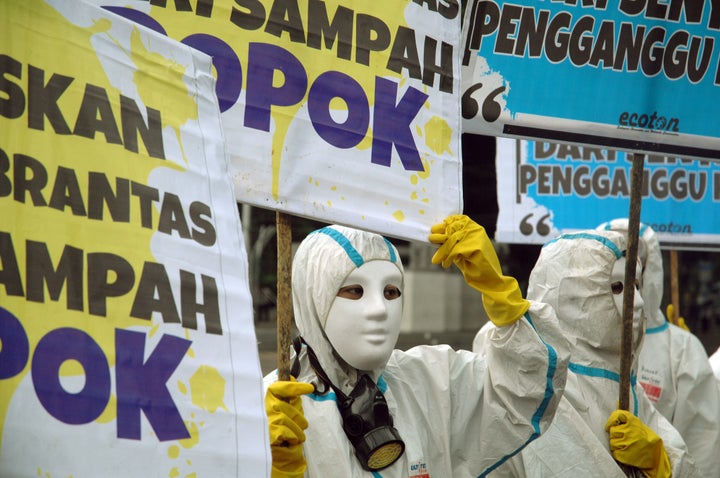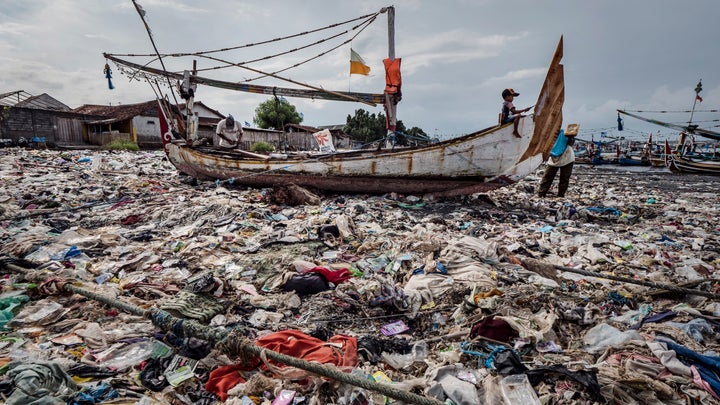The idea for throwaway diapers can be traced back to an anonymous nun working in the nursery of an Ohio hospital.
Back in the mid-1950s, industrial historians say, she proposed that U.S. consumer goods giant Procter & Gamble invent a replacement for cloth diapers. She envisioned a time-saving, affordable, hygienic product to take the load off busy mothers.
Since then, the disposable diaper industry has grown into an immense, $65 billion-a-year monster. Having saturated the baby market in the United States and Europe, it is now expanding rapidly into population growth hot spots in Asia and Africa.
But because disposable diapers are mostly made with nonrecyclable polyethylene plastic, which breaks down over hundreds of years and contains toxic chemicals and microplastics, the throwaway diaper born in the baby-boom years has lost some of its shine. Environmental activists are now targeting these products as an emblem of consumer society and a source of one of the world’s fastest-growing waste problems.
The numbers are staggering. Until human babies are fully potty-trained, they poop in diapers four or more times a day. With over 300,000 babies born worldwide every day, and parents increasingly choosing disposables, it’s estimated that people are using and chucking hundreds of billions of diapers every year. A single baby creates an estimated 1,000 pounds of poo a year, so by any count, that’s an awful lot of untreated waste.

In the U.S. and Europe, plastic diapers are one of the largest categories of nonbiodegradable items in landfill sites. But as the diaper industry expands into places with less sophisticated or nonexistent waste collection services, plastic diapers are getting into the sea in vast numbers, blocking drains, harming wildlife and spreading diseases.
“Dirty nappies could be considered the most harmful item of marine litter,” said Jo Royle, director of Common Seas, an environmental nonprofit working to set up plastic waste collection systems in the Maldives, Greece and elsewhere.
“Science has shown that nappies are causing disease on coral reefs,” Royle noted. “It is shocking and distressing to see children play on beaches full of dirty diapers.”
Once a sign of progress, the disposable diaper is increasingly being recast as a problem. In India, where around 27 million children are born a year and a growing middle class is turning to disposables, authorities are worried that diapers are not being discarded properly.
“Dirty nappies could be considered the most harmful item of marine litter.”
- Jo Royle, director of Common Seas
“Sanitary waste disposal has become an increasing problem,” the country’s Central Pollution Control Board wrote last year in guidelines for how diapers should be managed. The board recommends burial or incineration.
Despite strict traditional rules governing the disposal of bodily fluids in many societies, the lure of disposables is too much for many families. It is leading to a culture clash.
In Indonesia, where the population has doubled to 270 million people in just 45 years, plastic diaper waste hit like a bomb. All over Java, the country’s most populous island, waterways are clogged with plastic trash, including used diapers. The Brantas River, a water source for 6 million people in the eastern part of the island, has become notorious for its diaper problem.

Many communities believe that burning or burying diapers will cause sickness and skin rashes in children. Elders say that if the soiled diapers are instead thrown into the river, the baby will not suffer.
Canals and irrigation ditches are popular places to toss them.
“Disposable diapers are a huge problem. You see people just throwing them into the rivers all the time,” said Fully Syafi, a photographer in Surabaya, East Java, who volunteers with the nonprofit Diaper Evacuation Brigade.
“We do clean-ups and provide boxes for people to put them [in], but it is the culture to throw them into water,” Syafi explained. “It’s difficult to get people to change. We estimate 1.5 million a day are thrown into the main river Brantas alone.”
Diapers create even more ocean pollution than plastic bags in Java, according to Ecological Observation and Wetlands Conservation (Ecoton), a small Indonesian environmental group.
Ecoton has found plastic fibers, likely from diapers, in 80 percent of the fish examined in the Brantas River. “The fish swallow the pieces of plastic, which can be transferred from the stomach to the meat,” said Ecoton research manager Riska Darmawanti. “When people eat the fish, the plastic will be transferred to their bodies.”
Another frontier for giant diaper companies is Africa.
“Disposable diapers have become one of the most urgent environmental problems in our area, especially where waste removal services are limited or nonexisting,” said Philip Owen, who works with South African water conservation group Geasphere in rural communities in Mpumalanga province.
“Over 4 billion plastic diapers are sold every year in South Africa alone,” he said. “As soon as people have a bit of money, they buy them. Municipalities cannot keep up. People end up with bags of dirty diapers and nowhere to go. So people dump bags next to the road.”

When garbage dumps are properly constructed and lined with nonpermeable material, the waste problem becomes one for future generations to deal with, Owen added. “But most waste dumps in Africa are not ‘lined’ ― so the human waste and chemicals contained in disposable diapers [leach] into the underground water and environment, leading to increased environmental degradation and escalating health risks.”
Owen and others advocate reusable cloth diapers and redesigning disposable nappies to be compostable. They also recommend establishing collection points where used nappies can be collected and recycled.
Big diaper companies are rattled. Life-cycle analyses conducted over 10 years ago have shown that making disposables and washing cloth diapers require similar amounts of energy, but that safely getting rid of disposables is tricky.
In a statement to HuffPost, Procter & Gamble’s northern European press office said the company has made its products 50% smaller since the 1980s, cutting down on the amount of waste in each diaper. The company is also experimenting with diaper recycling programs.
“This is a global issue,” says Alex Burkert, a senior manager at Softex, Indonesia’s second-largest diaper-maker. “We are trying to educate people not to throw their diapers into the rivers. We are running a project to recycle them, and extract the paper and plastic.”
Industry body Edana says that companies are trying different ways of production and collection, but making compostable or biodegradable diapers is a complicated matter. “The right facilities are required at a municipal level because home composting is very unlikely,” said communications director Sean Kerrigan. “Bacterial infection from nappies can also be an issue in the composting chain. Biodegradable nappies are conceptually possible but technically not easy.”
Edana thinks advanced recycling technologies that can separate out the plastic are the best way forward. A pilot program is underway in Amsterdam, where 70% of parents say they want to recycle diapers. The program will place “smart” bins in daycare centers and drug stores, with parents using an app to locate and use them. Procter & Gamble has helped launch a diaper recycling factory in Italy, and researchers in Taiwan have built a recycling machine that can handle 220 pounds of dirty diapers an hour. Plenty of past attempts at recycling programs have failed or stalled, however.
No one in the industry thinks that recycling plants and smart bins are going to roll out across Africa or Asia any time soon. Until then, parents may be forced to choose between convenience and pollution.
This story is part of a series on plastic waste funded by SC Johnson. All content is editorially independent, with no influence or input from the company.

